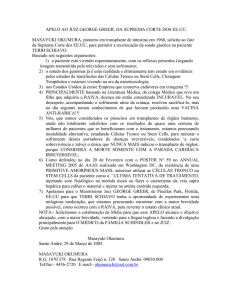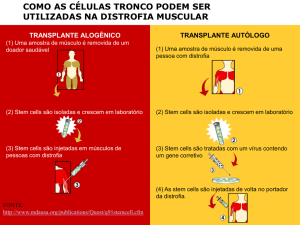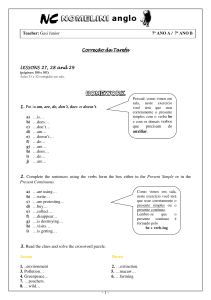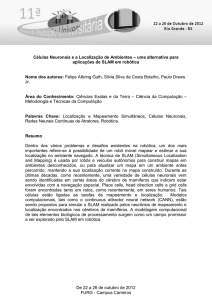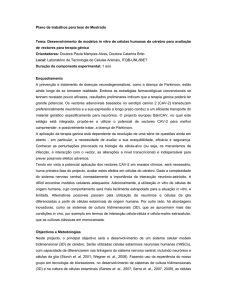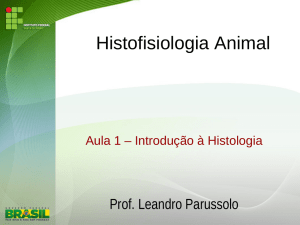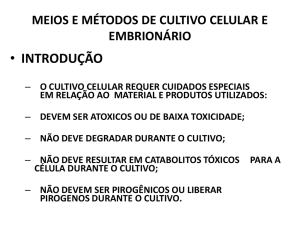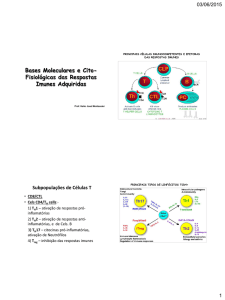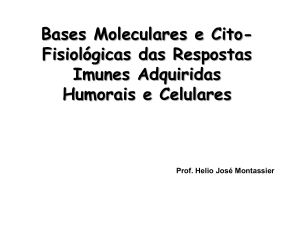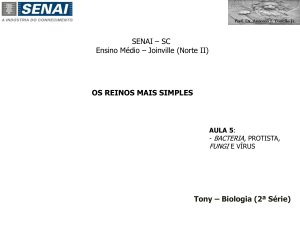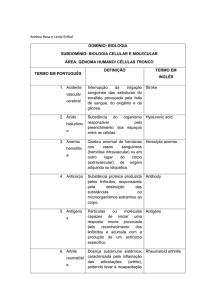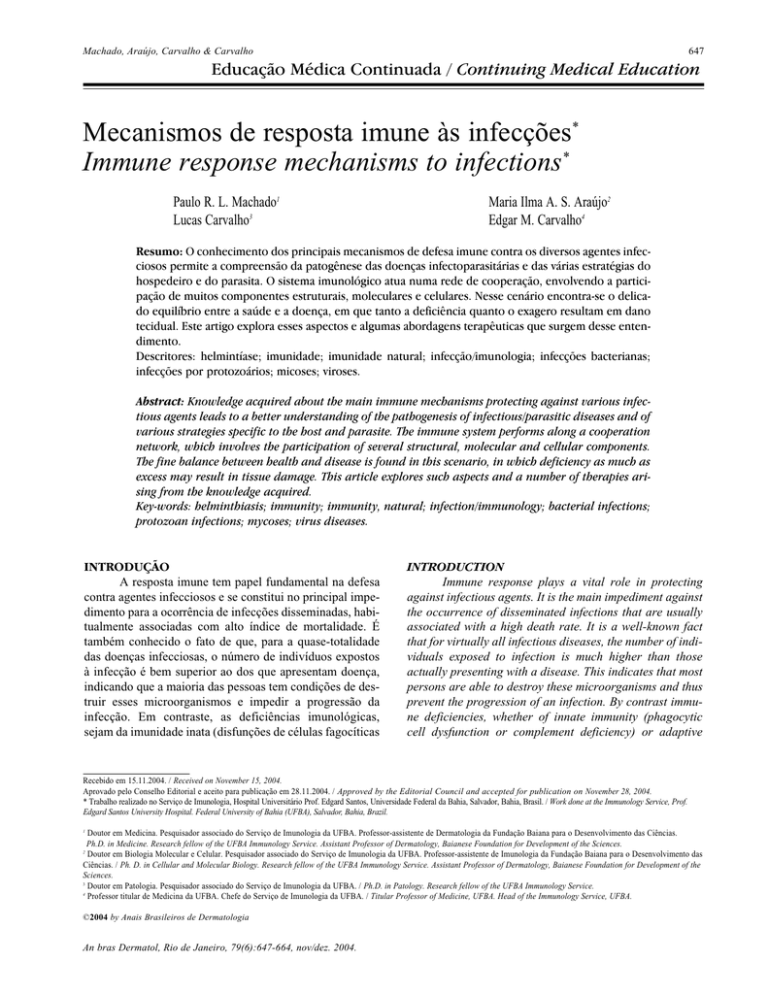
Machado, Araújo, Carvalho & Carvalho
647
Educação Médica Continuada / Continuing Medical Education
Mecanismos de resposta imune às infecções*
Immune response mechanisms to infections*
Paulo R. L. Machado1
Lucas Carvalho3
Maria Ilma A. S. Araújo2
Edgar M. Carvalho4
Resumo: O conhecimento dos principais mecanismos de defesa imune contra os diversos agentes infecciosos permite a compreensão da patogênese das doenças infectoparasitárias e das várias estratégias do
hospedeiro e do parasita. O sistema imunológico atua numa rede de cooperação, envolvendo a participação de muitos componentes estruturais, moleculares e celulares. Nesse cenário encontra-se o delicado equilíbrio entre a saúde e a doença, em que tanto a deficiência quanto o exagero resultam em dano
tecidual. Este artigo explora esses aspectos e algumas abordagens terapêuticas que surgem desse entendimento.
Descritores: helmintíase; imunidade; imunidade natural; infecção/imunologia; infecções bacterianas;
infecções por protozoários; micoses; viroses.
Abstract: Knowledge acquired about the main immune mechanisms protecting against various infectious agents leads to a better understanding of the pathogenesis of infectious/parasitic diseases and of
various strategies specific to the host and parasite. The immune system performs along a cooperation
network, which involves the participation of several structural, molecular and cellular components.
The fine balance between health and disease is found in this scenario, in which deficiency as much as
excess may result in tissue damage. This article explores such aspects and a number of therapies arising from the knowledge acquired.
Key-words: helminthiasis; immunity; immunity, natural; infection/immunology; bacterial infections;
protozoan infections; mycoses; virus diseases.
INTRODUÇÃO
A resposta imune tem papel fundamental na defesa
contra agentes infecciosos e se constitui no principal impedimento para a ocorrência de infecções disseminadas, habitualmente associadas com alto índice de mortalidade. É
também conhecido o fato de que, para a quase-totalidade
das doenças infecciosas, o número de indivíduos expostos
à infecção é bem superior ao dos que apresentam doença,
indicando que a maioria das pessoas tem condições de destruir esses microorganismos e impedir a progressão da
infecção. Em contraste, as deficiências imunológicas,
sejam da imunidade inata (disfunções de células fagocíticas
INTRODUCTION
Immune response plays a vital role in protecting
against infectious agents. It is the main impediment against
the occurrence of disseminated infections that are usually
associated with a high death rate. It is a well-known fact
that for virtually all infectious diseases, the number of individuals exposed to infection is much higher than those
actually presenting with a disease. This indicates that most
persons are able to destroy these microorganisms and thus
prevent the progression of an infection. By contrast immune deficiencies, whether of innate immunity (phagocytic
cell dysfunction or complement deficiency) or adaptive
Recebido em 15.11.2004. / Received on November 15, 2004.
Aprovado pelo Conselho Editorial e aceito para publicação em 28.11.2004. / Approved by the Editorial Council and accepted for publication on November 28, 2004.
* Trabalho realizado no Serviço de Imunologia, Hospital Universitário Prof. Edgard Santos, Universidade Federal da Bahia, Salvador, Bahia, Brasil. / Work done at the Immunology Service, Prof.
Edgard Santos University Hospital. Federal University of Bahia (UFBA), Salvador, Bahia, Brazil.
1
Doutor em Medicina. Pesquisador associado do Serviço de Imunologia da UFBA. Professor-assistente de Dermatologia da Fundação Baiana para o Desenvolvimento das Ciências.
Ph.D. in Medicine. Research fellow of the UFBA Immunology Service. Assistant Professor of Dermatology, Baianese Foundation for Development of the Sciences.
2
Doutor em Biologia Molecular e Celular. Pesquisador associado do Serviço de Imunologia da UFBA. Professor-assistente de Imunologia da Fundação Baiana para o Desenvolvimento das
Ciências. / Ph. D. in Cellular and Molecular Biology. Research fellow of the UFBA Immunology Service. Assistant Professor of Dermatology, Baianese Foundation for Development of the
Sciences.
3
Doutor em Patologia. Pesquisador associado do Serviço de Imunologia da UFBA. / Ph.D. in Patology. Research fellow of the UFBA Immunology Service.
4
Professor titular de Medicina da UFBA. Chefe do Serviço de Imunologia da UFBA. / Titular Professor of Medicine, UFBA. Head of the Immunology Service, UFBA.
©2004 by Anais Brasileiros de Dermatologia
An bras Dermatol, Rio de Janeiro, 79(6):647-664, nov/dez. 2004.
648
Machado, Araújo, Carvalho & Carvalho
e deficiência de complemento) ou da imunidade adaptativa
(deficiência de produção de anticorpos ou deficiência da
função de células T), são fortemente associadas com
aumento de susceptibilidade a infecções.1
Embora a resposta imune seja fundamental para a
defesa contra a maioria de agentes infectantes, têm sido acumuladas nos últimos anos evidências de que em muitas doenças infecciosas os principais aspectos patológicos não estão
relacionados com uma ação direta do agente agressor, mas
sim com uma resposta imune anormal. Em muitas dessas
situações existe uma reação de hipersensibilidade com resposta imune exagerada e não modulada que tem como conseqüência dano tecidual. Em outros casos, agentes infecciosos,
seja por mimetizar antígenos próprios, por induzir proliferação de células auto-reativas ou por aumentar nas células
infectadas a expressão de moléculas de MHC e moléculas coestimulatórias, podem desencadear doenças auto-imunes.2
O conhecimento de que diferentes tipos de micróbios
são combatidos por diferentes componentes da resposta
imune data do início dos anos 50, quando ficou documentada
a importância dos anticorpos na destruição de bactérias extracelulares. Embora isoladamente os anticorpos por si só não
tenham a capacidade de destruir bactérias, anticorpos podem
neutralizar os microorganismos, impedindo sua ligação com
o tecido do hospedeiro. Adicionalmente, em associação com
o complemento, os anticorpos podem lisar bactérias e funcionar como opsoninas, facilitando a fagocitose. Os neutrófilos,
eosinófilos e macrófagos exercem sua ação microbicida de
forma mais ampla contra vários tipos de agentes e são células
importantíssimas para a defesa do hospedeiro. A documentação de que células fagocíticas expressam em sua membrana
receptores como o toll-like receptor (TLR), que se ligam especificamente a padrões moleculares existentes em diversos
agentes infectantes,3 torna impróprio denominar inespecífica
a resposta imune inata. Os neutrófilos têm ação microbicida
fundamental contra bactérias; os macrófagos são células
importantes na defesa contra agentes intracelulares (protozoários e bactérias intracelulares); e os eosinófilos, não tanto
pela atividade fagocítica, mas pela atividade citotóxica contra
helmintos. A resposta mediada pelas células T é extremamente efetiva no mecanismo de defesa contra agentes intracelulares, como vírus, protozoários, fungos e bactérias intracelulares. As células T podem exercer sua função através da citotoxicidade mediada por células CD8+ ou através da secreção de
citocinas que vão ativar macrófagos para destruir os agentes
intracelulares. Outros elementos que podem participar do
processo de defesa contra agentes infecciosos incluem o queratinócito e a célula de Langerhans, já que muitas vezes a pele
é invadida por diversos microorganismos. Os queratinócitos
possuem a capacidade de secretar inúmeras citocinas, dessa
maneira ativando e recrutando células inflamatórias e linfócitos para a pele.4 A célula de Langerhans, por sua vez, exerce
o papel fundamental de vigilante do território cutâneo, fagocitando desde partículas protéicas inanimadas até vírus, bactérias ou qualquer outro microorganismo invasor. Após a
An bras Dermatol, Rio de Janeiro, 79(6):647-664, nov/dez. 2004.
immunity (antibody production deficiency or T-cell function deficiency), are strongly associated with increased
susceptibility to infections.1
Although immune response is fundamental for protecting against most infectious agents, evidence has been
accumulating over the years as to how in many infectious
diseases the main pathological aspects are not related to
the direct action of an aggressor agent, but instead to
abnormal immune response. In several such situations,
there exists a hypersensitivity reaction with exaggerated
and non-modulated immune response, the result of which is
tissue damage. In other cases, infectious agents, whether
by mimicking the antigens themselves, by inducing a proliferation of self-reactive cells or by increasing the expression of MHC and co-stimulatory molecules in infected cells
can precipitate autoimmune diseases.2
That different types of microbes are combated by
different immune response components has been known
since the beginning of the 1950s, when the importance of
antibodies on the destruction of extracellular bacteria was
first documented. Although antibodies on their own and in
isolation are not able to destroy bacteria, they may neutralize microorganisms by preventing them from binding to
the host tissue. Furthermore, in association with the complement, antibodies may lyse bacteria and function as
opsonins, thereby facilitating phagocytosis. Neutrophils,
eosinophils and macrophages exert their microbicid
action most broadly against various types of agents and
are extremely important cells for protecting the host.
Documentation on how phagocytic cells express their
receptor membranes like the toll-like receptor (TLR),
which binds specifically with existing molecular patterns
in various infectious agents, 3 makes it inaccurate to name
innate immune response non-specific. Neutrophils play a
fundamental microbicid role against bacteria; macrophages are important cells for defending against intracellular
agents (protozoan and intracellular bacteria). Eosinophils
are essential not so much due to phagocytic activity as to
cytotoxic activity against helminthes. T-cell mediated response is highly effective for the protection mechanism
against intracellular agents, like viruses, protozoans, funguses and intracellular bacteria. T-cells may exercise
their function through cytotoxicity mediated by CD8+ cells
or through the secretion of cytokines, which activate
macrophages to destroy intracellular agents. Other elements that may participate in the process of protecting
against infectious agents included keratinocyte and
Langerhans cell, since the skin is often invaded by various
microorganisms. Keratinocytes are able to secrete innumerable cytokines, thereby activating and recruiting
inflammatory cells and lymphocytes for the skin.4 The
Langerhans cell in turn exercises a fundamental role of
watching over the cutaneous territory, and phagocyting
everything from particular inanimate proteins up to and
including viruses, bacteria or other microorganism inva-
Machado, Araújo, Carvalho & Carvalho
649
fagocitose a célula de Langerhans migra para o linfonodo
regional a fim de realizar a apresentação antigênica aos linfócitos, dando início ao desenvolvimento de imunidade específica protetora, tolerância ou hipersensibilidade.5
Se de um lado já eram conhecidas as células e os
mediadores envolvidos nas defesas dos humanos, só recentemente foi documentado o fato de que a população de células
TCD4+ (T helper) é heterogênea, sendo constituída de duas
subpopulações: as células Th1 e Th2.6 Essa observação tem
contribuído bastante para o entendimento da imunopatogênese
da maioria das doenças infecciosas. A figura 1 mostra a dicotomia das células TCD4+ e os mediadores por elas produzidos.
É fundamental o entendimento de que tanto a resposta Th1 como a resposta Th2 são importantes na defesa do hospedeiro contra as infecções. A resposta Th1 está relacionada
com a defesa contra protozoários, bactérias intracelulares e
vírus, enquanto a resposta Th2 é mais efetiva contra os helmintos e bactérias extracelulares. Essas respostas são também
antagônicas, desde que o IFN-γ modula negativamente a resposta Th2, e a IL-4 e a IL-10 modulam negativamente a resposta Th1, o que permite uma homeostasia no sistema imune
e uma resposta imunológica balanceada. Adicionalmente, as
células regulatórias da resposta imune que expressam as
moléculas CD4 e CD25 (Tr) e produzem IL-10 e/ou TGF-β (Tr1
ou Th3) estão envolvidas em modular a resposta imune, impedindo ou diminuindo as conseqüências das reações de hipersensibilidade e das doenças auto-imunes.7
ders. After phagocytosis the Langerhans cell migrates to
the regional lymph node to carry out the antigenic presentation of the lymphocytes, which begins the development of
specific protector immunity, tolerance or hypersensitivity.5
The cells and mediators involved in protecting
humans are well known. Yet the fact that TCD4+ (T helper)
are heterogeneous and made up of two subpopulations,
namely Th1 and Th2 cells, has only recently been documented.6 This observation has contributed a lot to understanding the immunopathogenesis of the most infectious diseases. Figure 1 shows the dichotomy of the TCD4+ cells and
mediators produced by them.
It is vital to understand that both Th1 and Th2 responses are important in the task of protecting the host
against infection. Th1 response is related to protecting
against protozoans, intracellular bacteria and viruses,
while Th2 response is more effective against helminthes and
extracellular bacteria. These responses are also antagonistic, insofar as the IFN-gamma negatively modulates Th2
response, and IL-4 and IL-10 negatively modulate Th1 response. This enables homeostasis in the immune system and
a balanced immune response. In addition, the regulatory
cells of immune response which express molecules CD4 and
CD25 (Tr) and produce IL-10 and/or TGF-beta (Tr1 or Th3)
are involved in modulating immune response. They prevent
or reduce the consequences of hypersensitivity reactions
and auto-immune diseases.7
1. RESPOSTA IMUNE CONTRA BACTÉRIAS
As bactérias são os microorganismos que mais freqüentemente causam infecções no homem. Tanto as barreiras naturais contra os agentes infectantes, como a imunidade inata e a adaptativa participam do mecanismo de defesa
contra as bactérias.
1. IMMUNE RESPONSE AGAINST BACTERIA
Bacteria are the microorganisms that most frequently cause infections in humans. The natural barriers
against infection agents as well as innate and adaptive
immunity participate in the protection mechanism against
bacteria.
Figura 1: Subpopulações das células T CD4+ e principais citocinas produzidas
Figure 1: T CD4+ cell subpopulations and the main cytokines produced
Adaptada do Immunobiology, Janeway, CA et al., 5th Ed / Adapted from Immunobiology, Janeway, CA et al., 5th Ed
An bras Dermatol, Rio de Janeiro, 79(6):647-664, nov/dez. 2004.
650
Machado, Araújo, Carvalho & Carvalho
1.1. Bactérias Intracelulares
A característica principal é a capacidade de sobreviver dentro dos macrófagos, tendo como exemplos o M.
tuberculosis, o M. leprae e a L. monocitogenesis. A penetração no macrófago constitui também um mecanismo de
escape do parasita e, embora paradoxal, é também útil para
o hospedeiro, desde que a ausência de penetração celular da
bactéria poderia induzir uma forte resposta inflamatória e
um excessivo dano para o hospedeiro. Dentro dos macrófagos essas bactérias podem estimular tanto as células TCD4+
através da expressão de antígeno associado ao MHC classe
II, como também células TCD8+ através da expressão de
antígenos associados a moléculas do MHC classe I. A ativação de células TCD4+ leva à secreção de IFN-γ, que ativa
os macrófagos levando à produção aumentada de óxido
nítrico (NO) e destruição da bactéria. As células TCD8+
participam do mecanismo de defesa através da citotoxicidade, destruindo os macrófagos infectados. No caso do M.
tuberculosis, a despeito de haver imunidade protetora
impedindo sua multiplicação, não existe a eliminação completa do bacilo. Por essa razão indivíduos em uso de corticosteróides e portadores de HIV podem desenvolver manifestações clínicas de tuberculose, a despeito de terem sido
infectados há muito tempo e terem persistido completamente assintomáticos. O papel da resposta imune celular no
controle das infecções causadas por micobactérias é bem
demonstrado pela expansão dessas infecções com o advento da Aids.
Com referência à infecção causada por M. leprae, o
espectro clínico da doença está intimamente ligado à resposta imune. Nos pacientes com a forma tuberculóide existe uma forte resposta Th1, e a doença se caracteriza por destruição das fibras nervosas em áreas específicas, levando ao
aparecimento na pele de lesões localizadas e bem demarcadas, com perda de sensibilidade térmica e dolorosa. Na
ausência de uma resposta Th1, ocorre disseminação do
bacilo, levando ao quadro da hanseníase virchowiana.
Nesse caso os macrófagos estão repletos de parasita e há
escassez de linfócitos na lesão. As formas borderlines, também conhecidas como dimorfas, representam um padrão
clínico e imunológico de resposta intermediária.8
A importância da resposta imune na hanseníase não
se restringe à determinação do espectro clínico; no decorrer da doença ou muitas vezes após início do tratamento
alguns pacientes podem apresentar manifestações clínicas
agudas secundárias à liberação de antígenos e a reações de
hipersensibilidade. Essas manifestações, também denominadas reações, são representadas pelo eritema nodoso hansênico (ENH) e pela reação reversa (RR). O ENH é uma
resposta inflamatória sistêmica associada a altas concentrações de TNF-α e à deposição de imunocomplexos, com
infiltração de neutrófilos e ativação de complemento,
comprometendo vários órgãos.9,10 A imunopatogênese do
ENH é bastante complexa: têm sido demonstrados no soro
dos pacientes altos níveis circulantes de IL-1 e TNF-α,11,12
An bras Dermatol, Rio de Janeiro, 79(6):647-664, nov/dez. 2004.
1.1. Intracellular Bacteria
The main characteristic is the ability to survive
within the macrophages, for example M. tuberculosis, M.
leprae and L. monocitogenesis. Penetration into the
macrophage also constitutes the parasite’s escape mechanism. Although paradoxical, the latter is benign for the
host insofar as the lack of cellular penetration by the bacteria may induce a strong inflammatory response and
excessive damage for the host. Within the macrophages
these bacteria may stimulate either TCD4+ cells by an
expression of the antigen associated to MHC class II or
TCD8+ cells by an expression of the antigens associated
with molecules of MHC class I. Activation of TCD4+ cells
lead to the secretion of IFN-gamma, which activates the
macrophages and leads to increased production of nitrous
oxide (NO) and destruction of bacteria. TCD8+ cells participate in the protection mechanism through cytotoxicity,
thereby destroying the infected macrophages. In the case of
M. tuberculosis, despite having immune protection preventing its multiplication, there is no complete elimination of
the bacillus. For this reason, individuals using corticosteroids and HIV-positive patients develop clinical signs of
tuberculosis, despite having been infected much earlier and
after remaining completely asymptomatic. The role of cellular immune response in controlling infections caused by
mycobacteria is well demonstrated in how these infections
have spread with the advent of AIDS.
Regarding infections caused by M. leprae, the clinical spectrum of the disease is intimately linked to immune
response. In patients having a tuberculoid form, there is a
strong response to Th1. Also, the disease is characterized by
destruction of the nervous fibers in specific areas leading to
the appearance of localized and well-delimited skin lesions,
with a loss of sensitivity to heat and pain. When Th1 response is lacking, there is a dissemination of of the bacillus,
which leads to Virchowian Hanseniasis. In this event, the
macrophages are replete with the parasite and there is a
thickness of lymphocytes found on the lesion. Borderline
forms, also known as dimorphic, represent a clinical and
immunological pattern of intermediary response. 8
The importance of immune response in Hanseniasis
disease is not limited to the determination of its clinical spectrum. With the onset of disease or often after treatment is started, some patients may show acute secondary clinical signs
after the release of antigens and hypersensitivity reactions.
These manifestations—also called reactions—are represented by erythema nodosum leprosum (ENL) and reverse reaction (RR). ENL is a systemic inflammatory response associated with high concentrations of tumor necrosis factor alpha
(TNF-alpha) and the deposition of immunocomplexes with an
infiltration of neutrophils and the activation of a complement,
involving various organs.9,10 The immunopathogenesis of ENL
is quite complex. High levels of circulating IL-1 and TNFalpha,11,12 have been found in patients’ feces, whereas a tissue
increase in the expression of messenger RNA by IL-6, IL-8 and
Machado, Araújo, Carvalho & Carvalho
enquanto um aumento tecidual na expressão de RNA mensageiro para IL-6, IL-8 e IL-10 indica resposta Th2;10,13 além
disso, é documentada a presença da enzima óxido nítrico
sintase induzível ( iNOS) nos neutrófilos e de TNF-α e TGFβ nos macrófagos das lesões.14 O ENH pode acompanharse de toxicidade sistêmica, sendo muitas vezes tratado
com corticosteróides ou drogas inibidoras do TNF-α, como
a talidomida. Por outro lado, a RR desenvolve-se após o
aparecimento abrupto de um mecanismo de hipersensibilidade tardia contra frações antigênicas do M. leprae, envolvendo participação ativa de linfócitos T com produção
tecidual de citocinas Th1 (IL-2, IFN-γ) e citocinas inflamatórias, como TNF-α.13 As lesões apresentam-se infiltradas
por linfócitos CD4+, com aumento da expressão de HLADR e do receptor para IL-2 em células do infiltrado, assim
como nos queratinócitos. 15
1.2. Bactérias Extracelulares
As infecções causadas por bactérias extracelulares
são as mais freqüentes. Nesses casos os mecanismos de
defesa estão relacionados principalmente com as barreiras
naturais do hospedeiro, a resposta imune inata e a produção
de anticorpos.
A importância das barreiras naturais no combate às
infecções bacterianas extracelulares é bem reconhecida. A
integridade da pele e das mucosas impede a aderência e a
penetração de bactérias; o movimento mucociliar elimina
bactérias do trato respiratório; o pH ácido do estômago destrói bactérias que penetram pelo trato digestivo alto; e na
saliva e secreções prostáticas existem substâncias com atividade antimicrobiana. A quadro 1 detalha os principais
mecanismos de defesa contra bactérias extracelulares.
A participação da imunidade inata ocorre através das
células fagocitárias, da ativação do sistema complemento
pela via alternativa e da produção de quimiocinas e citocinas.
Adicionalmente a proteína C reativa (PCR), proteína de fase
aguda produzida principalmente por células hepáticas nas
infecções bacterianas, exerce ação variada contra as bactérias.
Ao ligar-se aos fosfolipídios de membrana de algumas bactérias (por exempço, pneumococos) a PCR atua como opsonina, facilitando a fagocitose por neutrófilos. A PCR tem também a capacidade de ativar o sistema complemento e também
651
IL-10 indicates Th2 response.10,13 Moreover, the presence of the
inductible nitrous oxide synthase enzyme (iNOS) has been
documented as potentially being induced in the neutrophils
and TNF-alpha and TGF-beta in the macrophages of the
lesions.14 ENL may be accompanied by systemic toxicity,
which is often treated with corticosteroids or TNF-alpha inhibitory drugs, like thalidomide. On the other hand, RR develops in the wake of the abrupt emergence of a delayed hypersensitivity mechanism against antigenic fractions of M.
leprae, involving the active participation of T lymphocytes
with tissue production of Th1 cytokines (IL-2, IFN-gamma)
and inflammatory cytokines, like TNF-alpha.13 The lesions
appear to be infiltrated by CD4+ lymphocytes, with increased
expression of HLA-DR and of the receptor IL-2 in cells of the
infiltrate, just as with those in the keratinocytes.15
1.2. Extracellular Bacteria
Infections caused by extracellular bacteria are the
most frequent of all. In these cases, the protection mechanisms are mainly related to the host’s natural barriers,
innate immune response and antibody production.
The importance of natural barriers in the fight
against extracellular bacterial infections is well known.
The integrity of skin and mucosas prevent adherence and
penetration of bacteria; mucociliar movement eliminates
bacteria from the respiratory tract; the stomach’s acidic pH
destroys bacteria penetrating by the upper digestive tract;
and in the saliva and prostatic secretions there exist substances with antimicrobial activity. Chart 1 provides details
of the main protection mechanisms against extracellular
bacteria.
The participation of innate immunity occurs
through phagocyte cells, the activation of a complement
system through an alternative path and by production of
chemokines and cytokines. In addition, C-reactive protein
(CRP), an acute phase protein produced mainly by hepatic
cells in bacterial infections, exerts a diversified range of
action against the bacteria. When binding to phospholipids
of the membrane of some bacteria (for example, pneumoccocus) CRP works like opsonin, facilitating the phagocytosis by neutrophils. CRP also has the capacity to activate the
complementary system and stimulates the synthesis of TNF-
Quadro 1: Mecanismos de defesa contra bactérias extracelulares
Chart 1: Protection mechanisms against extracellular bacteria
I. Barreiras naturais contra as infecções / Natural barriers against infection
II. Imunidade inata / Innate immunity
1. Moléculas extracelulares (proteína C reativa, complemento) / Extracellular molecules (C reactive protein, complement)
2. Células NK, neutrófilos, macrófagos / NK cells, neutrophils, macrophages
3. Quimiocinas, citocinas / Chemokines, cytokines
III. Imunidade adquirida / Aquired immunity
1. Anticorpos / Antibodies
2. Citocinas produzidas por células T / Cytokines produced by T cells
An bras Dermatol, Rio de Janeiro, 79(6):647-664, nov/dez. 2004.
652
Machado, Araújo, Carvalho & Carvalho
estimula a síntese de TNF-α, a qual induz a síntese de NO e
conseqüentemente a destruição de vários microorganismos.
O complemento exerce seu papel de defesa pela ativação do complexo de ataque à membrana (C5-C9) e facilitando a opsonização através do componente C3b, que se
liga à bactéria e interage em uma segunda etapa com um
receptor específico existente nas células fagocíticas. As
deficiências do sistema complemento têm sido associadas
com infecções graves por Neisseria meningitidis e infecções disseminadas por Neisseria gonorheae.16
Todas as células da imunidade inata participam da
defesa contra bactérias, embora seja enfatizado principalmente o papel de neutrófilos e monócitos/macrófagos pela capacidade fagocítica dessas células. Os basófilos e mastócitos ativados por fatores do sistema complemento, a exemplo do C5a,
C3a e C4a, liberam mediadores que, juntamente com as referidas proteínas do complemento, atraem leucócitos para o sítio
de agressão e contribuem para a passagem dessas células dos
vasos para os tecidos, local onde está ocorrendo a agressão ao
hospedeiro. Os eosinófilos, além da atividade fagocítica,
podem destruir microorganismos por meio da liberação de
proteínas com atividade microbicida, tais como a proteína
básica principal e a proteína catiônica eosinofílica. Os neutrófilos e os macrófagos têm participação importante na defesa
contra esses agentes desde que as bactérias sejam susceptíveis
a substâncias produzidas por essas células, a exemplo do NO
e do peróxido de hidrogênio. Existem também no interior dessas células, enzimas como a mieloperoxidase e substâncias
outras como a azurocidina, que possuem propriedade microbicida. Embora tanto os neutrófilos como os macrófagos sejam
células fagocíticas, essas células possuem características bem
diferentes. Enquanto os neutrófilos têm vida curta tanto no
sangue como nos tecidos, os macrófagos têm sobrevida prolongada. Os neutrófilos só são encontrados nos tecidos inflamados, enquanto os macrófagos concentram-se tanto em tecidos inflamados como em tecido sadio. Durante a reação inflamatória os neutrófilos produzem secreção purulenta, enquanto os macrófagos formam o granuloma. Os neutrófilos defendem principalmente contra as bactérias extracelulares,
enquanto os macrófagos são fundamentais para a eliminação
dos agentes intracelulares que albergam.
As células da resposta imune são também as principais fontes de citocinas e quimiocinas no início das infecções, as quais exercem sua ação tanto na fase inata como na
adaptativa. As quimiocinas, devido a seu papel de atrair
células para o sítio da lesão, são muito importantes no processo de defesa do hospedeiro.17
Entre as várias citocinas que participam da defesa
contra bactérias, tem sido dado destaque às citocinas próinflamatórias, como o TNF-α, IL-1 e IL-6. Essas citocinas
são produzidas nas fases iniciais da infecção e são responsáveis, por meio de sua ação no hipotálamo, pelo aparecimento da febre que inibe a multiplicação bacteriana. Elas
aumentam a expressão das moléculas de adesão (seletina P
e ICAM), facilitando a passagem de células de vaso para o
An bras Dermatol, Rio de Janeiro, 79(6):647-664, nov/dez. 2004.
alpha, which induces the synthesis of NO and consequently
the destruction of various microorganisms.
The complement performs its protection role by
activating the attack complex at membrane (C5-C9) and
facilitates opsonization through the C3b component, which
binds to the bacteria and interacts at a second stage with
the specific receptor existing in phagocytic cells. The deficiencies of the complementary system have been associated
with serious infections by Neisseria meningitides and infections disseminated by Neisseria gonorheae.16
All innate immunity cells participate in protecting
against bacteria, though it is the role of neutrophils and
monocytes/macrophages that are mainly emphasized by the
phagocytic capacity of these cells. The basophiles and
mastocytes activated by factors of the complement system,
as in C5a, C3a and C4a for example, release mediators
which, when combined with the aforementioned complement proteins, attract leukocytes to the site of aggression
and contribute to the passage of these cells from the vessels
to the tissues, namely the site at which the aggression
against the host occurs. Apart from its phagocytic activity,
eosinophils may destroy microorganisms by means of
releasing proteins with microbicid activity, such as the
main basic protein and eosinophil cationic protein.
Neutrophils and macrophages play a key role in protecting
against these agents provided that bacteria are susceptible
to substances produced by these cells, for example NO and
hydrogen peroxide. Within these cells, enzymes like myeloperoxidase and other substances like azurocidin having
microbicid properties also exist. Although neutrophils as
well as macrophages are phagocytic cells, they have much
different characteristics. Whereas neutrophils have a short
lifespan in either the blood or tissues, macrophages survive over extended periods of time. Neutrophils are only
found in inflamed tissues, while macrophages are concentrated either in inflamed or healthy tissues. During the
inflammatory reaction, neutrophils produce purulent secretion, whereas the macrophages form granuloma.
Neutrophils mainly protect against extracellular bacteria,
whereas macrophages are vital to eliminate the intracellular agents that house them.
Immune response cells are also the main sources of
cytokines and chemokines at the onset of the infection. They
exert inhibitory action either on the innate or adaptive
phase. Due to their role of attracting cells to the lesion site,
chemokines are very important in the process of protecting
the host.17
Among the various cytokines that participate in protecting against bacteria, the pro-inflammatory cytokines,
like TNF-alpha, IL-1 and IL-6, are noteworthy. These cytokines are produced in the initial phases of the infection. By
means of their action on the hypothalamus, they are responsible for the appearance of a fever that inhibits bacterial multiplication. They increase the expression of adhesion molecules (Seletine P and ICAM), thereby easing the
Machado, Araújo, Carvalho & Carvalho
sítio da infecção, e também estimulam os neutrófilos e
macrófagos a produzirem NO e a destruírem bactérias.
Outras citocinas produzidas nas fases iniciais da infecção
interferem na resposta imune adaptativa. A IL-12, produzida
por macrófagos, tem papel importante na diferenciação de
células Th0 para Th1,18 enquanto a IL-4, produzida por basófilos, mastócitos e macrófagos, estimula a diferenciação de
células Th0 para Th2, que vão colaborar com o linfócito B
na produção de anticorpos, mais especificamente, da IgE.19
A imunidade adaptativa, principalmente mediante
os anticorpos, desempenha importante papel na defesa contra as bactérias extracelulares. Os anticorpos podem exercer suas ações de três maneiras: 1) opsonização, 2) ativando o sistema complemento, 3) promovendo a neutralização
de bactérias ou de seus produtos.
Como as bactérias extracelulares são susceptíveis à
destruião quando fagocitadas, elas desenvolvem, como
mecanismo de escape, substâncias que possuem atividade
antifagocítica. Anticorpos dirigidos contra essas substâncias
não só impedem sua ação, mas facilitam a fagocitose, desde
que neutrófilos e macrófagos possuam receptor para a porção FC da imunoglobulina (opsonização). Os anticorpos
também são coadjuvantes na destruição de bactérias por
complemento, ativando esse sistema pela via clássica. Por
meio do mecanismo de neutralização, os anticorpos, principalmente a IgA, podem ligar-se a bactérias e, com isso, impedir que as mesmas se fixem nas mucosas, como no trato
intestinal e no trato respiratório. Os anticorpos em muitas
ocasiões ligam-se a toxinas produzidas por bactérias, como
as toxinas tetânica e diftérica, neutralizando a ação desses
produtos.
A despeito da importância defensiva da resposta
imune, a dificuldade em controlar a resposta inflamatória
que se desenvolve pode provocar dano nos próprios tecidos,
muitas vezes limitado e sem maiores conseqüências para o
hospedeiro. Porém, eventualmente, infecções causadas por
germes gram-negativos podem resultar em septicemia e choque séptico, situação extremamente grave e associada com
alta taxa de mortalidade. O choque séptico é desencadeado
por lipopolissacarídeos (LPS) presentes na parede bacteriana
estimulando nos neutrófilos, macrófagos, células endoteliais
e músculos uma produção exacerbada de citocinas pró-inflamatórias (TNF-α, IL-1, IL-6, IL-8) e NO. Como conseqüência,
há diminuição do tônus muscular e do débito cardíaco, que
resulta em hipotensão e má perfusão tecidual, e finalmente
morte celular. No entanto, a modulação dessa resposta exacerbada pode ser obtida. Assim, em modelo experimental a
administração concomitante de IL-10 e LPS protege camundongos da morte por choque séptico, ao inibir a produção de
IL-12 e síntese de IFN-γ e TNF-α.20
2. RESPOSTA IMUNE NAS INFECÇÕES VIRAIS
A despeito dos múltiplos mecanismos de defesa
contra os vírus, as doenças virais não só são comuns, como
hoje representam uma das mais importantes doenças infecAn bras Dermatol, Rio de Janeiro, 79(6):647-664, nov/dez. 2004.
653
passage of cells from the vessel to the infection site. They
also stimulate neutrophils and macrophages to produce NO
and destroy bacteria. Other cytokines produced in the initial infection phases interfere with the adaptive immune
response. Produced by macrophages, IL-12 has an important role in the differentiation of Th0 cells into Th1 cells.18
By contrast, IL-4, produced by basophiles, mastocytes and
macrophages, stimulates a differentiation of Th0 cells into
Th2 cells, which end up collaborating with lymphocyte B in
the production of antibodies, but especially of IgE.19
Adaptive immunity, mainly by means of antibodies, performs an important role against these extracellular bacteria.
The antibodies may perform their inhibitory action in three
ways: 1) opsonization, 2) activating the complement system, 3)
promoting the neutralization of bacteria or its products.
Extracellular bacteria are susceptible to destruction
when phagocyted. They develop substances like the evasive mechanism that have antiphagocytic activity. Antibodies
aimed against these substances not only impede upon their
action, but facilitate phagocytosis, insofar as the neutrophils and macrophages have receptors for the FC portion of
the immunoglobulin (opsonization). Antibodies also coassist in destroying bacteria by the complement, and activate this system by a classic pathway. By means of the neutralization mechanism, the antibodies, primarily IgA, may
bind with the bacteria and accordingly prevent the latter
from establishing themselves in the mucosas, intestinal
tract and respiratory tract. Antibodies often bind to bacteria-produced toxins, like tetanic and diphtheric toxins, and
neutralize the action of these products.
Despite the protective importance of immune response, the difficulty in controlling the inflammatory response that develops may provoke tissue damage, which is nonetheless most often limited and without greater consequences
for the host. However, infections caused by gram-negative
germs may eventually result in septicemia and septic
shock—very serious situations usually associated with a
high mortality rate. Septic shock is triggered by lipopolyssacharides (LPS) present in the bacterial wall, which stimulate an exacerbated production of pro-inflammatory cytokines in the neutrophils, macrophages, endothelial cells and
muscles (TNF-alpha, IL-1, IL-6, IL-8) and NO. Muscle tone
and heart beat are reduced as a result, which leads to hypotension and poor tissue perfusion, and finally cellular
death. By contrast, modulation of this exacerbated response may be obtained. As such, in an experimental model, the
concomitant combination of IL-10 and LPS protects mice
from death during septic shock by inhibiting the production
of IL-12 and synthesis of IFN-gamma and TNF-alpha.20
2. IMMUNE RESPONSE IN VIRAL INFECTIONS
Despite the manifold mechanisms of protecting
against viruses, viral diseases are not only common, but in
fact represent one of the most important infectious diseases
today associated with mortality in the general population.
654
Machado, Araújo, Carvalho & Carvalho
ciosas associadas com a mortalidade da população. A figura 2 mostra como os vírus são destruídos por meio da
reposta imune inata. Na fase inicial das infecções virais, o
controle dessas infecções é feito pelos interferons tipo I
(IFN-α e IFN-β), pelos macrófagos e pelas células NK.21
Os interferons tipo I são produzidos por células
infectadas por vírus e, ao interagir com uma célula não
infectada, têm a propriedade de protegê-la contra a infecção,
além de colaborar com a resposta imune adaptativa. O IFNγ também atua contra as infecções virais mediante a ativação dos macrófagos com destruição dos vírus e também das
células NK (células citotóxicas naturais), as quais, pela liberação de granzima e perfurina, destroem as células infectadas. Adicionalmente, a IL-12 possui participação importante na fase inicial, sendo produzida por macrófagos e outras
células apresentadoras de antígenos, estimulando as células
NK a exercer citotoxicidade e a produzir mais IFN-γ, que por
sua vez aumenta o potencial microbicida dos macrófagos.
A imunidade adaptativa contra os antígenos virais
ocorre com ativação de células TCD8+ que vão exercer citotoxicidade pelo reconhecimento de antígenos virais via
MHC classe I nas células alvo, e conseqüente liberação de
granzima e de perfurinas com lise das células infectadas e
também dos vírus. Durante a resposta imune adaptativa há
também ativação das células TCD4+, que vão colaborar com
as células B na produção de anticorpos. A despeito de os
vírus serem agentes intracelulares, os anticorpos têm papel
importante no combate às infecções virais, desde que, por
ocasião da propagação da infecção viral, após multiplicarem-se em células infectadas, os vírus rompem essas células, ficando livres até a penetração em outra célula. Nessa
fase extracelular os anticorpos podem ligar-se aos vírus e,
por meio do mecanismo de neutralização, impedir que eles
penetrem uma célula não infectada. Alternativamente, anticorpos podem ser adjuvantes no mecanismo de citotoxicidade celular dependente de anticorpos, ao se ligar às células
infectadas, permitindo a ação das células NK. Em várias
Figure 2 shows how viruses are destroyed by means of
innate immune response. In the initial phase of viral infections, controlling the infections is done with interferons
type I (IFN-alpha and IFN-beta), macrophages and NK
cells.21
Type I interferons are produced by virus-infected
cells. By interacting with a non infected cell, their feature
is to protect them against infection in addition to collaborating with adaptive immune response. IFN-gamma also
acts against virus infections by means of activating the
macrophages to destroy the virus as well as the NK cells
(natural cytotoxic cells) to release granzyme and perforin
and destroy infected cells. In addition, IL-12 plays an
important part in the initial phase. It is produced by
macrophages and other antigen-presenting cells. It stimulates NK to exert cytotoxicity and produce more IFNgamma, which in turn increases the microbicid potential of
macrophages.
Adaptive immunity against viral antigens occurs
with the activation of TCD8+ cells that exert cytotoxicity
when recognizing viral antigens via MHC class I in the target cells, with a result of releasing granzyme and perforins
with the lysing of the infected cells and virus. During adaptive immune response TCD4+ cells are also activated,
which then go on to collaborate with B cells to produce
antibodies. In spite of viruses being intracellular agents,
antibodies play an important role in fighting against viral
infections insofar as the viruses break open these cells and
remain free until penetrating into another cell. In this
extracellular phase, antibodies may bind to the virus, and
by means of the neutralization of the mechanism, prevent
others from penetrating a non infected cell. By contrast,
antibodies may assist in the cellular cytotoxicity mechanism that depends on them, by binding to the infected cells
and thereby allowing NK cell action. In various diseases, as
in the examples of poliomyelitis, measles, hepatitis B and
varicella, the antibody has a fundamental role in protecting
Figura 2: Os diversos mecanismos de atividade antiviral na imunidade inata
Figure 2: Diverse mechanisms of antiviral activity in innate immunity
An bras Dermatol, Rio de Janeiro, 79(6):647-664, nov/dez. 2004.
Machado, Araújo, Carvalho & Carvalho
doenças, a exemplo de poliomielite, sarampo, hepatite B e
varicela, o anticorpo tem papel fundamental na proteção
contra a infecção quando se trata de um hospedeiro previamente sensibilizado, seja por uma infecção prévia ou por
imunização. Isso porque, em indivíduos já sensibilizados, a
presença de anticorpos pode interceptar os vírus, impedindo
sua ligação com a célula do hospedeiro.
Em virtude dos múltiplos mecanismos de defesa
contra os vírus, grande parte das infecções virais é assintomática ou tem uma apresentação subclínica com manifestações inespecíficas, como febre e rash cutâneo. Todavia,
várias infecções virais progridem, e dano tecidual importante pode ocorrer. A patologia associada à infecção viral pode
estar relacionada com um efeito citopático do vírus, reação
de hipersensibilidade e fenômenos auto-imunes (Figura 3).
Em muitas infecções virais a destruição de célula
acontece por mais de um desses mecanismos. Por exemplo,
na infecção pelo HIV e nas infecções pelo vírus B e vírus C
da hepatite, a destruição da células infectada é mediada tanto
pelo efeito citopático do vírus como através de citotoxicidade por células NK e células CD8. Algumas infecções virais
exemplificam bem a ampla dimensão dos mecanismos de
agressão tecidual que ocorrem no curso dessas infecções.
2.1. Vírus da Imunodeficiência Humana (HIV)
O HIV infecta predominantemente as células TCD4+,
e a destruição dessas células pode ocorrer pelo efeito citopático do vírus. Adicionalmente, existe um aumento da apoptose dessas células e, por expressarem antígenos virais no
nível da membrana, as células podem também ser destruídas
por citotoxicidade mediada pela célula TCD8+, fenômeno
que também contribui para a redução das células CD4+.
Sendo a célula TCD4+ uma das mais importantes na cooperação da resposta imune, a diminuição numérica e a alteração de sua função levam a uma supressão da resposta imunológica. Essa supressão está associada predominantemente
com a diminuição de IL-2, IFN-γ e TNF-α.22 Por essa razão,
655
against infection when it is a previously sensitized host,
whether by a prior infection or immunization. This is
because, in already sensitized individuals, the presence of
antibodies can intercept the virus and thus prevent it from
binding to the host cell.
In virtue of several protective mechanisms against
viruses, a large part of viral infections are asymptomatic or
have a subclinical presentation with non specific manifestations, like fever and cutaneous rash. Nonetheless, various
viral infections do progress and important tissue damage
can occur. The pathology associated with viral infection
may be related to the virus’ cytopathic effect, hypersensitivity reaction and auto-immune phenomena (Figure 3).
In many viral infections, cells are destroyed
through a process involving more than one of these mechanisms. For example, in HIV-infection and infections by
hepatitis viruses B and C, the destruction of infected cells
is mediated as much by the virus’ cytopathic effect as
through cytotoxicity by NK and CD8 cells. Some viral
infections perfectly exemplify the broad dimension of
aggression mechanisms occurring against tissue in the
course of these infections.
2.1. Human Immunodeficiency Virus (HIV)
HIV infects TCD4+ cells predominantly. The destruction of these cells may occur by the virus’ cytopathic
effect. In addition, there exists increased apoptosis in these
cells. Due to expressing viral antigens at the level of the
membrane, the cells may also be destroyed by cytotoxicity
mediated by the TCD8+ cell, a phenomenon also contributing to the reduction of CD4+ cells. As the CD4+ cell is one
of the most important for obtaining the cooperation of
immune response, the numerical reduction and alteration
of its function leads to the suppression of immune response. This suppression is associated predominantly with a
reduction of IL-2, IFN-gamma and TNF-alpha.22 This is why
in AIDS patients, the main opportunistic infections are
Figura 3: Patologia Associada a Infecções Virais / Figure 3: Pathology associated with viral infections
An bras Dermatol, Rio de Janeiro, 79(6):647-664, nov/dez. 2004.
656
Machado, Araújo, Carvalho & Carvalho
em pacientes com Aids, as principais infecções oportunistas
estão relacionadas a agentes intracelulares, tais como: M.
tuberculosis, P. carinii, citomegalovírus, C. albicans e criptosporidium. Como na infecção pelo HIV os linfócitos B de
memória estão funcionando, anticorpos são produzidos, e o
mecanismo de defesa contra agentes extracelulares não é
prejudicado em grande escala. Essa ausência de maior susceptibilidade para infecções bacterianas extracelulares
observada em pacientes com Aids é, entretanto, observada
em adultos nos quais o repertório de anticorpos produzido
por células B e dependente de células T já estava formado
antes da infecção pelo HIV. Em crianças infectadas, como a
alteração do funcionamento das células TCD4+ é precoce, a
cooperação celular é prejudicada, havendo também anormalidade na síntese de anticorpos. Por esta razão, infecções por
bactérias extracelulares são comuns em crianças com HIV.
2.2. Vírus Linfocitotrópico de células T humanas
(HTLV-1)
A infecção pelo HTLV-1 induz ativação e intensa
proliferação celular dos linfócitos T infectados. Esse fenômeno relaciona-se principalmente com a função do gene
Tax do vírus que tem a propriedade de transativar os genes
da IL-2, e do receptor da IL-2. Essa proliferação anômala de
células T pode levar ao aparecimento da leucemia de células T do adulto. A proliferação indiscriminada de células
pode provocar também a expansão de células T auto-reativas e secreção acentuada de citocinas pró-inflamatórias
como o TNFα. Essas anormalidades podem associar-se
com lesão tecidual cutânea e neurológica.23
Em virtude da forte ativação de células Th1 na infecção pelo HTLV-1, ocorre uma redução da produção de IL-4
e IL-5 e diminuição da síntese da IgE e da ativação de mastócitos e eosinófilos, componentes da resposta protetora
contra helmintos. Assim, existe uma maior prevalência de
esquistossomose e estrongiloidíase em pacientes infectados
pelo HTLV-1,24 podendo ocorrer disseminação da larva do
S. stercoralis com aparecimento de formas graves de
estrongiloidíase.25
2.3. Papiloma vírus humano (HPV)
O HPV é um vírus DNA que, além de causar a verruga vulgar e o condiloma acuminado, está fortemente
associado ao desenvolvimento de neoplasia cervical e
desenvolvimento de câncer de pele, principalmente em
indivíduos imunossuprimidos. O envolvimento do HPV
com câncer de pele foi também demonstrado em pacientes
com epidermodisplasia verruciforme em que DNA viral foi
detectado em lesões maculares.26
A resposta imune contra o HPV de uma forma geral é
mediada pela resposta imune celular a despeito de anticorpos
da classe IgG e IgA contra frações antigênicas serem encontrados no muco cervical de pacientes com neoplasia cervical.27,28
Infiltrado inflamatório composto de macrófagos e células
CD4+ é observado em condilomas que regridem espontaneaAn bras Dermatol, Rio de Janeiro, 79(6):647-664, nov/dez. 2004.
related to intracellular agents such as: M. tuberculosis, P.
carinii, cytomegalovirus, C. albicans and criptosporidium.
As in HIV infection, memory B lymphocytes keep functioning, antibodies are produced and the protection mechanism against extracellular agents does not experience
large scale damage. However, this lack of greater susceptibility to extracellular bacterial infections observed in
AIDS patients is observed in adults in whom the repertory
of B-cell produced antibodies depending on T-cells had
already formed prior to HIV infection. In infected children,
as the alteration of TCD4+ cell functioning is premature,
cellular cooperation is damaged with abnormalities also
occurring in the synthesis of antibodies. This is why infections by extracellular bacteria are common in HIV-infected children.
2.2. Human T cell Lymphocytotropic virus
(HTLV-1)
Infection by the HTLV-1 induces activation and
intense cellular proliferation of infected T lymphocytes.
This phenomenon is related mainly to the function of the
virus’ Tax gene, whose property is to transactivate IL-2 and
IL-2-receptor genes. These T-cell proliferation anomalies
may lead to the appearance of leukemia in adult T cells.
Indiscriminate cell proliferation may also provoke an
expansion of self-reactive T cells and accentuated secretion
of pro-inflammatory cytokines like TNF-alpha. These
abnormalities may associate with cutaneous and neurological tissue lesions.23
Owing to the strong Th1 cell activation in HTLV-1
infection, there is reduced production of IL-4 and IL-5, and
a drop in IgE synthesis, in mastocytes and in eosinophil
activation. Both these components are features of the protective response against helminthes. Accordingly, there
exists a higher prevalence of schistosomiasis and strongyloidiases in patients infected by HTLV-1.24 There may also
be a dissemination of S. stercoralis with severe forms of
strongyloidiasis.25
2.3. Human papilloma virus (HPV)
HPV is a DNA virus that, apart from causing verruca vulgaris and condylomata acuminata, is strongly associated with the development of cervical neoplasia and skin
cancer, mainly in immunosuppressed individuals. HPV
involvement with skin cancer was also shown in patients
with epidermodysplasia verruciform in which viral DNA
was detected in macular lesions.26
Immune response against HPV in general is
mediated by cellular immune response, regardless of
whether class IgG and IgA antibodies against antigenic
fractions are found in the cervical mucous of patients
with cervical neoplasia.27,28 Inflammatory infiltrate consisting of macrophages and CD4+ cells is observed in
spontaneously regressing condylomata. The lymphoproliferative response of antigen-specific T CD4+ cells to E2
Machado, Araújo, Carvalho & Carvalho
mente, e a resposta linfoproliferativa de células T CD4+ específica para o antígeno E2 demonstrou-se associada à eliminação do HPV. Por outro lado, células CD8+ específicas para os
antígenos E6 e E7 são encontradas em pacientes com grandes
lesões ou com tumor cervical. Além disso, diminuição da resposta tipo 1 com baixa produção de IL-2, IFN-γ e TNF-α é
observada em pacientes com lesão intraepitelial de alto grau.29
3. RESPOSTA IMUNE NAS INFECÇÕES
CAUSADAS POR PROTOZOÁRIOS
As principais doenças causadas por protozoários no
homem são as leishmanioses, doença de Chagas, malária,
toxoplasmose e amebíase. Os protozoários são agentes
infecciosos intracelulares que habitualmente infectam o
hospedeiro por longo período de tempo, em virtude de possuir mecanismos que lhes permitem escapar das agressões
mediadas pelo sistema imune. De maneira adicional, as
infecções por protozoários habitualmente só causam doença em uma parcela dos indivíduos infectados, indicando
que o sistema imune não permite, na maioria das vezes, a
multiplicação em grande escala dos protozoários e a disseminação da infecção, sem, porém, ter a capacidade de promover esterilização. Dessa forma, esses agentes podem
permanecer no hospedeiro por toda a vida, até sem causar
doença, a não ser que esse equilíbrio seja perdido por uma
depressão imune ou pelo desencadeamento de uma resposta imunitária exacerbada com inflamação tecidual.
Vários componentes da resposta imune inata participam do mecanismo de defesa contra os protozoários, mas
esses microorganismos escapam dessa defesa.30 Embora in
vitro as promastigotas de Leishmania sejam altamente sensíveis ao complemento, as formas infectantes resistem a
sua ação. O Tripanosoma cruzi, por sua vez, tem a propriedade de impedir ativação do complemento, desde que se
encubra com moléculas do hospedeiro como o fator acelerador da degradação (DAF). As leishmanias são também
susceptíveis à ação de neutrófilos, células com grande
potencial de produzir peróxido de hidrogênio e NO, mas
que, ao penetrar o hospedeiro, infectam os macrófagos,
livrando-se do ataque dos neutrófilos. A resposta adaptativa contra os protozoários ocorre após a apresentação de
antígenos por macrófagos e células dendríticas, via MHC
classe II para as células T. Como outras células podem ser
infectadas, e os macrófagos e células dendríticas também
expressam moléculas de MHC classe I, nas infecções por
protozoários há também ativação das células TCD8+. O
quadro 2 mostra os mecanismos imunológicos de defesa
contra alguns protozoários de importância clínica.
À exceção da Giardia lamblia, que pode causar
infecção grave em pacientes com deficiência de produção
de anticorpos, a resposta imune celular é fundamental na
defesa contra infecções causadas por protozoários.
Embora nas infecções causadas por agentes intracelulares uma resposta imune desviada para o pólo Th2 seja
maléfica, porque aumenta a susceptibilidade às infecções e
An bras Dermatol, Rio de Janeiro, 79(6):647-664, nov/dez. 2004.
657
proved to be associated with the elimination of HPV. On
the other hand, specific CD8+ cells for antigens E6 and
E7 are found in patients with large lesions or a cervical
tumor. Furthermore, type 1 response reduction with a low
production of IL-2, IFN -gamma and TNF-alpha is observed in patients with a high-grade intraepithelial lesion.29
3. IMMUNE RESPONSE IN INFECTIONS CAUSED
BY PROTOZOANS
The main diseases caused by protozoans in human
beings are leishmaniases, Chagas disease, malaria, toxoplasmosis and amebiasis. Protozoans are infectious intracellular agents that usually infect the host for long periods
of time, owing to mechanisms that allow them to evade
from aggressions mediated by the immune system. In addition, infections by protozoans usually only cause disease in
some infected patients. This indicates that in most cases the
immune system does not allow large scale multiplication of
protozoans or the infection to spread, though it is unable to
foster sterilization. Accordingly, these agents may remain
in the host for its entire lifespan even without causing
disease, unless this balance is lost by immune depression
or by precipitation of an exacerbated immunitary response
with tissue inflammation.
Various immune response components participate in
the protection mechanism against protozoans, but these
microorganisms manage to evade this protection mechanism.30 Whereas in vitro the Leishmania promastigotes are
highly sensitive to the complement, infectant forms resist
their action. Tripanosoma cruzi, for instance, has a feature
of preventing the complement’s activation insofar it covers
itself with the host’s molecules as the degradation accelerator factor (DAF). Leishmania are also susceptible to the
action of neutrophils, cells having a large potential to produce hydrogen peroxide and NO. But when penetrating the
host, they infect the macrophages and make them vulnerable to a neutrophil attack. The adaptive response against
protozoans occurs after the presentation of antigens by
macrophages and dendritic cells, via MHC class II to the T
cells. As other cells may be infected, and macrophages and
dendritic cells also express MHC class I molecules, TCD8+
cells are also activated in protozoan infections. Chart 2
shows the immune protection mechanisms against some
clinically important protozoans.
With the exception of Giardia lamblia, which may
cause severe infection in patients who have an antibody
production deficiency, immune cellular response is fundamental in protecting against infections caused by protozoans.
Whereas with infections caused by intracellular
agents immune response deviated by the Th2 pole could
incur damages, due notably to the fact that susceptibility to
infection increases and this in turn allows the multiplication and dissemination of the parasite, the concept of whether a potent Th1 response is protective must be addressed
658
Machado, Araújo, Carvalho & Carvalho
permite a multiplicação e disseminação do parasito o conceito de que uma potente resposta Th1 seja protetora deve
ser visto com reserva. Em várias doenças causadas por protozoários, existem evidências de que a resposta imune exacerbada está envolvida no dano tecidual: na amebíase é
dependente da ação de neutrófilos;31 na doença de Chagas é
mediado por células CD4+ e CD8+;32 uma maciça produção
de TNF-α e NO, documentada na patogenia da malária cerebral.33 Esses fatos indicam que uma atuação equilibrada do
sistema imunológico é muito importante para a contenção
do parasita sem destruição tecidual, fazendo com que,
embora possa continuar presente, o agente infectante não
cause doença no homem.
A patogênese das diversas formas clínicas da leishmaniose exemplifica bem a importância da resposta Th1
tanto no controle como na gênese da lesão tecidual. As formas clínicas mais comuns da leishmaniose são a leishmaniose tegumentar (leishmaniose cutânea, leishmaniose
mucosa e leishmaniose cutânea difusa) e a leishmaniose
visceral. O quadro 3 mostra a associação entre as diversas
formas clínicas de leishmaniose, a espécie da Leishmania e
a resposta imune.
Após a inoculação da Leishmania na pele e invasão
macrofágica, nos indivíduos que não têm a capacidade de
produzir IFN-γ e ativar macrófagos, a Leishmania dissemina-se e, na dependência da espécie, causa a leishmaniose
visceral (L. chagasi) ou a leishmaniose cutânea difusa (L.
amazonensis). Nesses pacientes é fácil entender o desenvolvimento da doença, pela deficiência de IFN-γ e alta produção de IL-10. A restauração da resposta imune in vitro na
leishmaniose visceral pode ser observada pela neutraliza-
with some skepticism. In various protozoan-caused diseases, there is evidence that an exacerbated immune response is involved in tissue damage: in amebiasis, it depends on
neutrophil action; in Chagas disease it is mediated by
CD4+ and CD8+ cells;32 a massive production of TNFalpha and NO, documented in the pathogens of cerebral
malaria.33 These facts indicate that a balanced performance of the immune system is very important in order to contain the parasite without incurring any tissue destruction,
so that despite remaining in the host, the infecting agent
does not cause disease to the human being.
The pathogenesis of diverse clinical forms of leishmaniasis exemplifies well the importance of Th1 response
in the control and genesis of tissue lesions. The most common clinical forms of leishmaniasis are tegumentary leishmaniasis (cutaneous leishmaniasis, mucous leishmaniasis
and diffuse cutaneous leishmaniasis) and visceral leishmaniasis. Chart 3 shows the association between diverse clinical forms of leishmaniasis, the Leishmaniasis species and
immune response.
After inoculation of Leishmaniasis in the skin and the
macrophage invasion, in individuals unable to produce IFNgamma and activate macrophages, Leishmaniasis disseminates. Depending on the species, the latter causes visceral
leishmaniasis (L. chagasi), or diffuse cutaneous leishmaniasis (L. amazonensis). In these patients, it is easy to understand the development of the disease, which occurs through
IFN-gamma deficiency and high production of IL-10.
Restoration of immune response in vitro in visceral leishmaniasis may be observed by neutralizing IL-10 or adding IL-12
to peripheral blood mononuclear cell cultures (PBMNCC).34
Quadro 2: Principais mecanismos de defesa contra protozoários
Chart 2: Main protection mechanisms against protozoans
Protozoários
Protozoans
Células predominantemente infectadas
Predominantly infected cells
Mecanismos de defesa
Protection Mechanism
Leishmania
Macrófagos / Macrophages
Produção de IFN-γ, NO e citotoxicidade por célula CD8
Production of IFN-γ, NO and cytotoxicity by CD8 cell
Ameba
Neutrófilos, macrófagos / Neutrophil, macrophages Produção de IFN-γ e NO / Production of IFN-γ and NO
T. cruzi
Cardiomiócitos / Cardiomiocytes
Citotoxicidade por células CD8, ativação de macrófagos
por células CD4 e produção de NO
Cytotoxicity by CD8 cells, activation of macrophages by
CD4 cells and NO production
Toxoplasma gondii
Células do SNC, olhos, músculos, outras
SNC cells, eyes, muscles, others
Produção de NO por macrófagos ativados pelas células
TCD4+ e TCD8+
NO production by macrophages activated by TCD4+
and TCD8+ cells
Plasmodium
Hepatócitos / Hepatocytes
Citotoxicidade por células TCD8+ e produção de IFN-γ,
TNF-α e NO
Cytotoxicity by TCD8+ cells and production of of IFNalpha, TNF-alpha and NO
An bras Dermatol, Rio de Janeiro, 79(6):647-664, nov/dez. 2004.
Machado, Araújo, Carvalho & Carvalho
659
ção de IL-10 ou pela adição de IL-12 às culturas de células
mononucleares de sangue periférico (CMSP).34
Atípico, entretanto, é o que ocorre na leishmaniose
cutânea e na leishmaniose mucosa, situações nas quais
existe um forte desvio Th1 e, embora o número de parasitas no tecido seja escasso ou até ausente, há desenvolvimento de lesão. CMSP de indivíduos com leishmaniose
cutânea e leishmaniose mucosa estimuladas com antígeno
de Leishmania produzem grande quantidade de IFN-γ, IL2 e TNF-α, e pouca IL-10. Como habitualmente o sistema
imune não consegue destruir completamente as leishmanias, essa forte resposta Th1 termina por levar a ocorrência
de uma reação inflamatória muito intensa e a dano aos
tecidos próprios, resultando no aparecimento de úlceras na
pele e na mucosa. Tem participação importante nesse dano
tecidual a produção acentuada de TNF-α e de NO.
Evidências de que a resposta imune celular participa da
patogenia da leishmaniose cutânea e leishmaniose mucosa
incluem: 1) o tratamento precoce da infecção não impede
o aparecimento da lesão;35 2) existência de forte reação
inflamatória no tecido com expressão aumentada de TNFα, IFN-γ e poucos parasitos na lesão;34,36 3) associação de
antimonial com droga inibidora de TNF-α cura pacientes
com leishmaniose mucosa que são refratários ao tratamento com antimonial.37
4. RESPOSTA IMUNE A FUNGOS
O principal mecanismo de defesa contra fungos é
desenvolvido pelos fagócitos, que os destroem por meio da
produção de NO e de outros componentes secretados por
essas células. Adicionalmente, há participação de IFN-γ,
aumentando a função de neutrófilos e macrófagos, não
havendo evidências de atividade citotóxica por células T
CD8+. Portanto, pacientes que apresentam neutropenia
(menos de 500 neutrófilos/mm3) ou que tenham deficiência
da imunidade celular cursam com freqüência com micoses
recorrentes e ocasionalmente desenvolvem formas graves e
profundas.38
Embora um grande número de espécie de fungos
possa causar doenças no homem, a maioria deles causa doença limitada, sem maiores repercussões clínicas. Destacam-se
entre os fungos que estão associados com morbidade no
Brasil a Candida albicans, o Criptococcus neoformans e o
Paracoccidiodis braziliensis. Apesar de a infecção por C.
More atypical is what occurs to cutaneous leishmaniasis and mucous leishmaniasis, situations in which a
strong Th1 deviation exists. Even though the number of
parasites in the skin is thick or even absent, the lesion tends
to develop. PBMNCC of individuals with cutaneous leishmaniasis and mucous leishmaniasis stimulated with the
Leishmania antigen produces large amounts of IFNgamma, IL-2 and only slight amounts of IL-10. As the immune system does not usually manage to completely destroy
leishmania, this strong Th1 response prompts the occurrence of a very intense inflammatory reaction and damage to
the tissues themselves. This results in the appearance of
ulcers on the skin and mucosa. This damaged tissue also
participates considerably on the accentuated production of
TNF-alpha and NO. The evidence that cellular immune response participates in the pathogenesis of cutaneous leishmaniasis and mucous leishmaniasis includes: 1) premature treatment of the infection does not prevent the appearance of the lesion;35 2) the existence of a strong inflammatory
reaction in the tissue with an increased expression of TNFalpha, IFN-gamma and a few parasites on the lesion;34,36 3)
association of an antimonial with an inhibitor TNF-alpha
drug cures patients with mucous leishmaniasis, which are
otherwise refractory to antimonial treatment.37
4. IMMUNE RESPONSE TO FUNGUS
The main protection mechanism against funguses is
developed by phagocytes, which destroy them by producing
NO and other components developed by these cells. In
addition, there is participation of IFN-gamma. This enhances the function of neutrophils and macrophages, though
there is no evidence of cytotoxic activity by T CD8+ cells.
However, patients presenting with neutropenia (less than
500 neutrophils/mm3) or that have frequent cellular immune deficiency present with recurrent mycoses and occasionally develop severe and deep forms.38
Whereas a large number of fungus species may cause
diseases in humans, the majority of them cause limited
disease without greater clinical repercussions. Among the
funguses associated with morbidity in Brazil, we can highlight Candida albicans, Criptococcus neoformas and
Paraoccidiodis brasiliensis. In spite of the fact that infection
by C. albicans regularly causes light infections with no greater consequences, HIV-positive patients not only present with
Quadro 3: Resposta imune (produção de IFN-γ) e formas clínicas das infecções causadas por diferentes espécies de Leishmania / Chart 3: Immune response (production of IFN-gamma) and clinical forms of the infections caused by different species of Leishmania
Forma Clínica / Clinical Form
Visceral / Visceral
Difusa / Diffuse
Cutânea / Cutaneous
Mucosa / Mucus
Espécie / Specie
Produção de IFN-γ (pg/ml) / Production of IFN-gamma(pg/ml)
L. chagasi
L. amazonensis
L. braziliensis
L. braziliensis
An bras Dermatol, Rio de Janeiro, 79(6):647-664, nov/dez. 2004.
8+5
4+6
1146 + 382
4284 + 671
660
Machado, Araújo, Carvalho & Carvalho
albicans causar habitualmente infecções leves e sem maiores
conseqüências, pacientes infectados com HIV não apresentam
apenas alta prevalência da infecção por C. albicans, mas também envolvimento de esôfago, estômago e intestino, sendo
comuns infecções recorrentes. Em crianças que apresentam
alteração na resposta imune celular e distúrbios endócrinos
múltiplos, o quadro raro de candidíase mucocutânea crônica
é descrito. Nessas crianças observam-se uma diminuição da
resposta Th1 e lesões cutâneas, mucosas e ungueais graves.39
A despeito de a candidíase vaginal ser extremamente
freqüente e sem maiores conseqüências, cerca de 5% das
mulheres em idade reprodutiva apresentam um quadro de candidíase vaginal recorrente devido à ausência ou a baixos níveis
de IFN-γ, que pode ser restaurada in vitro pela neutralização da
IL-10.40 Embora não seja documentada uma resposta Th2 contra antígenos de C. albicans, a elevada freqüência de atopia
nessas pacientes sugere que uma reação de hipersensibilidade
imediata a diversos antígenos pode participar da patogênese
da doença, com alguns casos se beneficiando de imunoterapia.41
O Criptococcus neoformans pode causar doenças
pulmonares e comprometer o sistema nervoso central em
pacientes imunossuprimidos, e o P. braziliensis é o agente
causal da blastomicose sul-americana. A blastomicose sulamericana caracteriza-se por envolvimento de gânglios,
mucosa bucal e do aparelho respiratório. Na maioria das
pessoas infectadas o agente é controlado, e o indivíduo fica
completamente assintomático. Quando não se desenvolve
uma resposta Th1 há disseminação do fungo com envolvimento de órgãos do sistema reticuloendotelial e do pulmão;
nesse contexto o papel da IL-4 parece importante, já que em
modelo experimental a ausência dessa citocina protege
contra doença pulmonar grave.42
5. RESPOSTA IMUNOLÓGICA NAS INFECÇÕES
POR HELMINTOS
Os mecanismos de resposta imune nas infecções helmínticas são múltiplos devido ao tamanho e à diversidade
metabólica dos parasitas, que são antigenicamente complexos. Um problema adicional é que os parasitas podem sobreviver por muitos anos no hospedeiro, como resultado de
mecanismos de escape, a exemplo do que acontece com o S.
mansoni, que se torna coberto por antígenos do hospedeiro,
deixando de ser estranho para o sistema imunológico.43
Embora o complemento e outros fatores da resposta
imune natural possam contribuir para a defesa contra a
infecção por helmintos, a resposta imune específica com a
produção de anticorpos e citocinas é importante. As células
T CD4+ ou TCD8+ do tipo 2 são produtoras de citocinas
como IL-4, IL-5 e IL-13 que, entre outras funções, induzem
a produção de IgE pelas células B e ativação de eosinófilos,
mastócitos e basófilos, respectivamente, componentes fundamentais na defesa contra helmintos.44 Anticorpos da classe IgE ligam-se aos basófilos circulantes ou mastócitos teciduais, induzindo a liberação de histamina e outros mediaAn bras Dermatol, Rio de Janeiro, 79(6):647-664, nov/dez. 2004.
a high prevalence of C. albicans infection, but esophagus,
stomach, and intestine involvement are among the most
recurrent infections. In children presenting alterations in
cellular immune response and multiple endocrinal disturbances, a rare picture of chronic mucocutaneous candidiasis
is described. In these children, one observes a reduction in
Th1 response and severe cutaneous, mucous and ungual
lesions.39
Despite the fact that vaginal candidiasis is extremely frequent but with no greater repercussions, roughly
5% of women at reproductive age do present with a condition of recurrent vaginal candidiasis due to the absence of
or low levels of IFN-gamma, which may be restored in vitro
by neutralizing IL-10.40 Although there is no documentation
of Th2 response against C. albicans antigens, the high rate
of atopia in these patients suggest that an immediate hypersensitivity reaction to diverse antigens may participate in
the disease pathogenesis. Moreover, some cases may bring
benefits to immunotherapy. 41
Criptococcus neoformans may cause lung diseases
and compromise the central nervous system in immunosuppressed patients. P. braziliensis is the causal agent of southAmerican blastomycosis. South-American blastomycosis is
characterized by involvement of the ganglia, bucal mucosa
and respiratory apparatus. In most infected patients, the
agent is controlled and the individual remains completely
asymptomatic. When there is no development of Th1, there
is dissemination of the fungus with involvement of the
organs of the reticuloendothelial and pulmonary system; in
this context, the role of IL-4 seems important, given that in
an experimental model the absence of this cytokine protects
against severe pulmonary disease.42
5. IMMUNOLOGICAL RESPONSE IN HELMINTH
INFECTIONS
The immune response mechanisms in helminth
infections are manifold owing to the size and metabolic
diversity of the parasites, which are antigenically complex.
An additional problem is that the parasites may survive in
the host for several years. As a result mechanisms are evaded, an example of which occurs with S. mansoni which
ends up being covered by host antigens, and are no longer
foreign for the immunological system.43
Although the complement and other factors of natural immune response might contribute to protecting against
the helminth infections, specific immune response with the
production of antibodies and cytokines is important. The T
CD4+ or TCD8+ type 2 cells are producers of cytokines like
IL-4, IL-5 and IL-13 which, among their other functions,
induce IgE production by B cells and activate the fundamental components in protecting against helminths, namely
eosinophils, mastocytes and basophiles, respectively. Class
IgE antibodies bind to circulating basophiles or tissue mastocytes. This induces the release of histamine and other
reaction mediators of immediate hypersensitivity leading to
Machado, Araújo, Carvalho & Carvalho
dores da reação de hipersensibilidade imediata, que leva à
destruição de helmintos. A IgE produzida em altos níveis
na resposta imunológica do tipo Th2 tem sido relacionada
com defesa contra reinfecção pelo S. mansoni.45 Eosinófilos
têm também a capacidade de destruir os esquistossômulos
e o Strongyloides através do mecanismo de citotoxicidade
celular dependente do anticorpo.46 As células do tipo Th2
estão associadas com a resistência à infecção não apenas do
S. mansoni, mas dos helmintos intestinais, a exemplo do S.
stercoralis e A. lumbricoides. A IL-4 estimula a produção
de IgE e, juntamente com a IL-13, a de mastócitos, resultando em aumento da secreção de mediadores da inflamação,
secreção de muco e aumento da contratilidade da musculatura intestinal, facilitando a expulsão dos vermes adultos.47
Na fase aguda da esquistossomose as manifestações
clínicas de febre, astenia, perda de peso, dor abdominal,
diarréia e tosse, além de complicações como pleurite e pericardite, são decorrentes da presença de TNF-α, IL-1 e IL-6,
e também da deposição de complexos imunes.48 A melhora
da sintomatologia coincide com a produção de IL-10 induzida pelos antígenos de ovos na fase crônica.49 Nessa fase
também ocorre secreção de IL-4, IL-5 e IL-13,50,51 que em
modelos experimentais participam da formação do granuloma e da fibrose hepática, e, portanto, da patogênese da
esquistossomose.
q
661
the destruction of helminths. The IgE produced in high
levels in type Th2 immunological response has been related
to protecting against reinfection by S. mansoni.45
Eosinophils also have the capacity to destroy schistosomula and strongyloides through the cytotoxicity cellular
mechanism that depends on the antibody. Th2 type cells are
associated with a resistance to infection not only by S.
mansoni, but by intestinal helminths, for example S. stercoralis and A. lumbricoides. IL-4 stimulates IgE production
and, in combination with IL-13, mastocytes. This results in
increased secretion of inflammation mediators, secretion of
mucus and enhanced contractility of intestinal musculature, which facilitates the expulsion of adult worms.47
In the acute phase of schistosomiasis, the clinical
manifestations of fever, asthenia, weight loss, abdominal
pain, diarrhea and coughing, in addition to complications
such as pleuritis and pericarditis, result from the presence
of TNF-alpha, IL-1 and IL-6, and also the deposition of
immune complexes.48 Improvement of symptomatology coincides with the production of IL-10 induced by egg antigens
in the chronic phase.49 This phase also features secretion of
IL-4, IL-5 and IL-13,50,51 that experimental models participate in the formation of granuloma and hepatic fibrosis, and
yet in the pathogenesis of schistosomiasis.
q
REFERÊNCIAS / REFERENCES
1. Janeway CA Jr. How the immune system protects the host from
infection. Microbes Infect. 2001;3:1167-71.
2. Cooke A, Zaccone P, Raine T, Phillips JM, Dunne DW. Infection
and autoimmunity: are we winning the war, only to lose the peace?
Trends Parasitol. 2004;20:316-21.
3. Pasare C, Medzhitov R. Toll-like receptors and acquired immunity. Semin Immunol. 2004;16:23-6.
4. Debenedictis C, Joubeh S, Zhang G, Barria M, Ghohestani RF.
Immune functions of the skin. Clin Dermatol. 2001; 19:573-85.
5. Romani N, Holzmann S, Tripp CH, Koch F, Stoitzner P.
Langerhans cells - dendritic cells of the epidermis. APMIS.
2003;111:725-40.
6. Mosmann TR, Coffman RL. TH1 and TH2 cells: different patterns of lymphokine secretion lead to different functional properties. Annu Rev Immunol. 1989;7:145-73.
7. Mills KH, McGuirk P. Antigen-specific regulatory T cells-their
induction and role in infection. Semin Immunol. 2004;16:107-17.
8. Britton WJ, Lockwood DNJ. Leprosy. The Lancet.
2004;363:1209-19.
9. Goulart IMB, Penna GO, Cunha G. Imunopatologia da
hanseníase: a complexidade dos mecanismos da resposta imune do
hospedeiro ao Mycobacterium leprae. Rev Bras Med Trop. 2002,
35:365-75.
10. Naafs B. Leprosy reactions. New knowledge. Trop Geogr
Med. 1994;46:80-4.
11. Moreira AL, Sampaio EP, Zmuidzinas A, Frindt P, Smith KA,
Kaplan G. Thalidomide exerts its inhibitory action on tumor necrosis factor alpha by enhancing mRNA degradation. J Exp Med.
1993;177:1675-80.
12. Sarno EN, Grau GE, Vieira LM, Nery JA. Serum levels of
An bras Dermatol, Rio de Janeiro, 79(6):647-664, nov/dez. 2004.
tumour necrosis factor-alpha and interleukin-1 beta during leprosy
reactional states. Clin Exp Immunol. 1991;84:103-8.
13. Yamamura M, Wang XH, Ohmen JD, Uyemura K, Rea TH,
Bloom BR, et al. Cytokine patterns of immunologically mediated
tissue damage. J Immunol. 1992;149:1470-5.
14. Foss NT. Aspectos imunológicos da hanseníase. Medicina
(Ribeirão Preto) 1999; 30: 335-9.
15. Modlin RL, Melancon-Kaplan J, Young SMM, Pirmez C, Kino
H, Convit J, et al. Learning from lesions: patterns of tissue inflammation in leprosy. Proc Natl Acad Sci USA. 1988; 85: 1213-7.
16. Barrington R, Zhang M, Fischer M, Carroll MC. The role of
complement in inflammation and adaptive immunity. Immunol
Rev. 2001;180:5-15.
17. Dong VM, McDermott DH, Abdi R. Chemokines and diseases.
Eur J Dermatol. 2003;13:224-30.
18. Manetti R, Parronchi P, Giudizi MG, Piccinni MP, Maggi E,
Trinchieri G, et al. Natural killer cell stimulatory factor (interleukin
12 [IL-12]) induces T helper type 1 (Th1)-specific immune
responses and inhibits the development of IL-4-producing Th cells.
J Exp Med. 1993;177:1199-204.
19. Bacharier LB, Geha RS. Molecular mechanisms of IgE regulation. J Allergy Clin Immunol. 2000;105:S547-58.
20. Caille V, Bossi P, Grimaldi D, Vieillard-Baro A.
Physiopathology of severe sepsis. Presse Med. 2004;33:256-61.
21. Chadha KC, Ambrus JL Jr, Dembinski W, Ambrus JL Sr.
Interferons and interferon inhibitory activity in disease and therapy.
Exp Biol Med. 2004; 229:285-90.
22. Kedzierska K, Crowe SM. Cytokines and HIV-1: interactions and
clinical implications. Antivir Chem Chemother. 2001;12:133-50.
23. Barmak K, Harhaj EW, Wigdahl B. Mediators of central nerv-
662
Machado, Araújo, Carvalho & Carvalho
ous system damage during the progression of human T-cell
leukemia type I-associated myelopathy/tropical spastic paraparesis.
J Neurovirol. 2003;9:522-9.
24. Porto AF, Neva FA, Bittencourt H, Lisboa W, Thompson R,
Alcântara L, Carvalho EM. HTLV-1 decreases Th2 type of immune
response in patients with strongyloidiases. Parasite Imunol. 2001;
23:503-07.
25. Porto MA, Muniz A, Oliveira Junior J, Carvalho EM. Clinical
and immunological consequences of the association between
HTLV-1 and strongyloidiasis. Rev Soc Bras Med Trop.
2002;35:641-9.
26. Pfister H, Ter Schegget J. Role of HPV in cutaneous premalignant and malignant tumors. Clin Dermatol. 1997;15:335-47.
27. Dillner L, Bekassy Z, Jonsson N, Moreno-Lopez J, Blomberg J.
Detection of IgA antibodies against human papillomavirus in cervical secretions from patients with cervical intraepithelial neoplasia. Int J Cancer. 1989;43:36-40.
28. Dillner L, Fredriksson A, Persson E, Forslund O, Hansson BG,
Dillner J. Antibodies against papillomavirus antigens in cervical
secretions from condyloma patients. J Clin Microbiol.
1993;31:192-7.
29. Lee BN, Follen M, Shen DY, Malpica A, Adler-Storthz K,
Shearer WT, et al. Depressed type 1 cytokine synthesis by superantigen-activated CD4+ T cells of women with human papillomavirus-related high-grade squamous intraepithelial lesions. Clin
Diagn Lab Immunol. 2004;11:239-44.
30. Zambrano-Villa S, Rosales-Borjas D, Carrero JC, Ortiz-Ortiz L.
How protozoan parasites evade the immune response. Trends
Parasitol. 2002;18:272-8.
31. Ventura-Juarez J, Jarillo-Luna RA, Fuentes-Aguilar E, PinedaVazquez A, Munoz-Fernandez L, Madrid-Reyes JI, et al. Human
amoebic hepatic abscess: in situ interactions between trophozoites,
macrophages, neutrophils and T cells. Parasite Immunol
2003;25:503-11.
32. Gomes JA, Bahia-Oliveira LM, Rocha MO, Martins-Filho OA,
Gazzinelli G, Correa-Oliveira R. Evidence that development of
severe cardiomyopathy in human Chagas' disease is due to a Th1specific immune response. Infect Immun. 2003;71:1185-93.
33. Artavanis-Tsakonas K, Tongren JE, Riley EM. The war
between the malaria parasite and the immune system: immunity,
immunoregulation and immunopathology. Clin Exp Immunol.
2003;133:145-52.
34. Ribeiro de Jesus A, Almeida RP, Lessa H, Bacellar O, Carvalho
EM. Cytokine profile and pathology in human leishmaniasis. Braz.
J. Med. Biol. Res. 1998;31:143-8.
35. Machado P, Araujo C, Da Silva AT, Almeida RP, D'Oliveira Jr
A, Bittencourt A, et al. Failure of early treatment of cutaneous
leishmaniasis in preventing the development of an ulcer. Clin Infect
Dis. 2002;34:E69-73.
36. Pirmez C, Yamamura M, Uyemura K, Paes-Oliveira M,
Conceição-Silva F, Modlin RL. Cytokine patterns in the pathogenesis of human leishmaniasis. J Clin Invest. 1993; 91: 1390-5.
37. Lessa HA, Machado P, Lima F, Cruz AA, Bacellar O, Guerreiro
J, et al. Successful treatment of refractory mucosal leishmaniasis
with pentoxifylline plus antimony. Am J Trop Med Hyg. 2001;
65:87-9.
38. Romani L. Immunity to fungal infections. Nat Rev Immunol.
An bras Dermatol, Rio de Janeiro, 79(6):647-664, nov/dez. 2004.
2004;4:1-23.
39. Lilic D. New perspectives on the immunology of chronic mucocutaneous candidiasis. Curr Opin Infect Dis. 2002;15:143-7.
40. Carvalho LP, Bacellar O, Neves N, de Jesus AR, Carvalho EM.
Downregulation of IFN-gamma production in patients with recurrent vaginal candidiasis. J Allergy Clin Immunol. 2002;109:102-5.
41. Moraes PS, de Lima Goiaba S, Taketomi EA. Candida albicans
allergen immunotherapy in recurrent vaginal candidiasis. J Investig
Allergol Clin Immunol. 2000;10:305-9.
42. Pina A, Valente-Ferreira RC, Molinari-Madlum EE, Vaz CA,
Keller AC, Calich VL. Absence of interleukin-4 determines less
severe pulmonary paracoccidioidomycosis associated with
impaired Th2 response. Infect Immun. 2004;72:2369-78.
43. Neva FA, Brown HW. Basic clinical parasitology. Appleton &
Lange; 1994. p. 107-144.
44. Else KJ, Finkelman FD. Intestinal nematode parasites, cytokines
and effector mechanisms. Int J Parasitol. 1998; 28: 1145-58.
45. Demeure CE, Rihet P, Abel L, Ouattara M, Bourgois A, Dessein
AJ. Resistance to Schistosoma mansoni in humans: influence of the
IgE/IgG4 balance and IgG2 in immunity to reinfection after
chemotherapy. J Infect Dis. 1993; 168: 1000-8.
46. MacDonald A, Araujo MI, Pearce EJ. Immunology of parsitic
helminth infection. Infect Immun. 2002; 70:427-33.
47. Finkelman FD, Shea-Donohue T, Goldhill J, Sullivan CA,
Morris SC, Madden KB, Gause WC, Urban JF Jr. Cytokine regulation of host defense against parasitic gastrointestinal nematodes:
lessons from studies with rodent models. Annu Rev Immunol.1997;
15:505-33.
48. Butterworth AE. Immunological aspects of human schistosomiasis. Br Med Bull. 1998; 54:357-68.
49. Grzych JM, Pearce E, Cheever A, Caulada ZA, Caspar P, Heiny
S, et al. Egg deposition is the major stimulus for the production of
Th2 cytokines in murine schistosomiasis mansoni. J Immunol.
1991; 146: 1322-7.
50. Araujo MI, de Jesus AR, Bacellar O, Sabin E, Pearce E,
Carvalho EM. Evidence of a T helper type 2 activation in human
schistosomiasis. Eur J Immunol. 1996; 26: 1399-403.
51. Malaquias LC, Falcão PL, Silveira AM, Gazzinelli G, Prata A,
Coffman RL, et al. Cytokine regulation of human immune response
to Schistosoma mansoni: analysis of the role of IL-4, IL-5 and IL10 on peripheral blood mononuclear cell responses. Scand J
Immunol. 1997; 46: 393-8.
ENDEREÇO PARA CORRESPONDÊNCIA : / MAILING ADDRESS:
Paulo R. L. Machado
Serviço de Imunologia - 5º andar
Hospital Universitário Prof. Edgard Santos – UFBA
Rua João das Botas s/n - Canela
Salvador Bahia
40110-160
Fax: (71) 245-7110
E-mail: [email protected]

